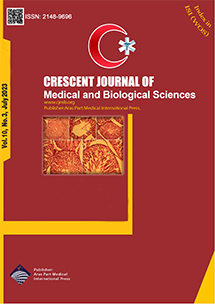
| Original Article | |
| Does Endometrial Compaction Predict Clinical Pregnancy Rate after Cleavage Stage Frozen Embryo Transfer? | |
| Mina Naghi Jafarabadi1, Maedeh Ahmadi Dastjerdi1, Batool Hossein Rashidi1, Mamak Shariat2, Fedyeh Haghollahi1 | |
| 1Vali-E-Asr Reproductive Health Research Center, Family Health Research Institute, Tehran University of Medical Sciences, Tehran, Iran 2Maternal, Fetal & Neonatal Research Center, Tehran University of Medical Sciences, Tehran, Iran |
|
|
CJMB 2023; 10: 132-136 DOI: 10.34172/cjmb.2023.22 Viewed : 3997 times Downloaded : 2612 times. Keywords : Endometrium/diagnostic imaging, Frozen-warmed embryo transfer, Pregnancy outcome |
|
| Full Text(PDF) | Related Articles | |
| Abstract | |
Objectivess: This study aimed to determine the relationships between endometrial compaction and pregnancy outcome in patients receiving artificial endometrial preparation for frozen embryo transfer (FET) cycles. Materials and Methods: This prospective cohort study was performed in a university-affiliated fertility clinic from March 2020 to March 2021. The eligible women undergoing their first or second FET cycle and having the top grading cleavage stage embryos were enrolled. All patients received the same endometrial preparation regime. The alteration in endometrial thickness (EMT) between the day of progesterone initiation and the day of embryo transfer (ET) was measured using consecutive transvaginal sonography. The patients were divided into three groups based on the percentage of endometrial compaction (i.e., the difference of EMT at end of the estrogen-only phase and after three days of progesterone administration (ET day) divided by the EMT on the terminal day of the estrogen-only exposure). Results: Overall, 300 eligible women were evaluated and only 27.3% (82/300) of the studied cycles showed ≥5% compaction, whereas 72.6% (218/300) either expanded or showed minimal compaction. The clinical and ongoing pregnancy rates in group 2 (any expansion) were significantly higher than those in groups 1 and 3 (P = 0.002 and P = 0.01, respectively). Multivariable logistic regression test indicated that the cycles with any expansion in ET were independently associated with 3.1 times improvement in clinical pregnancy rate in comparison to those with any compaction (P = 0.002). Conclusion: Gross endometrial compaction occurred in one-third of FET cycles with no significant positive effect on pregnancy outcomes after cleavage-stage ET. |
Cite By, Google Scholar
Google Scholar
PubMed
Online Submission System
 CJMB ENDNOTE ® Style
CJMB ENDNOTE ® Style
 Tutorials
Tutorials
 Publication Charge
Medical and Biological Research Center
About Journal
Publication Charge
Medical and Biological Research Center
About Journal
Aras Part Medical International Press Editor-in-Chief
Arash Khaki
Deputy Editor
Zafer Akan

















